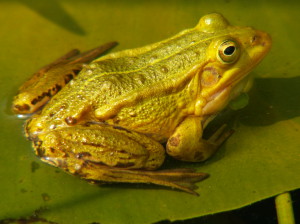Pool frog
 The most aquatic of our amphibians is the pool frog, which can be encountered in water all year round. Pool frogs, often referred to as edible frogs, is considerably smaller than the marsh frog. Its maximal length comprises 100 mm. Yet, it is the biggest of the native frogs. The pool frog’s body is green, which conceals it amidst water plants. Breeding males have large white vocal sacs. The frog is diurnal, resting at the bottom of the pool at night. It mainly feeds on terraneous insects: dipterans, dragonflies, beetles, ants, including the flying morphs. It forages in the upper parts of the aquatic plants and ashore at the water edge. It winters in water, and reaches sexual maturity in the 3rd year. Its roe serves as food for mallards, its tadpoles – to black-headed gulls, with adult species hunted by white-winged black terns, bitterns, buzzards, and moorhens.
The most aquatic of our amphibians is the pool frog, which can be encountered in water all year round. Pool frogs, often referred to as edible frogs, is considerably smaller than the marsh frog. Its maximal length comprises 100 mm. Yet, it is the biggest of the native frogs. The pool frog’s body is green, which conceals it amidst water plants. Breeding males have large white vocal sacs. The frog is diurnal, resting at the bottom of the pool at night. It mainly feeds on terraneous insects: dipterans, dragonflies, beetles, ants, including the flying morphs. It forages in the upper parts of the aquatic plants and ashore at the water edge. It winters in water, and reaches sexual maturity in the 3rd year. Its roe serves as food for mallards, its tadpoles – to black-headed gulls, with adult species hunted by white-winged black terns, bitterns, buzzards, and moorhens.
/ * The photos at lake.peipsi.org are cross-posted from commons.wikimedia.org and are used for familiarization purposes only. No commercial use of the photos is allowed. For more information about to use the photos see the originals on commons.wikimedia.org. /


